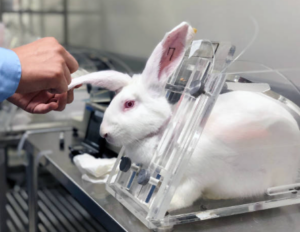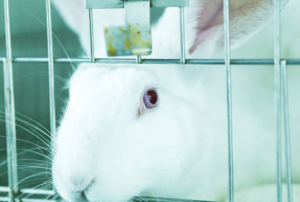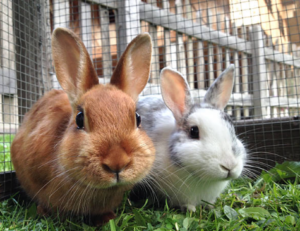From Tragedy to Triumph

In the vast realm of beauty and cosmetics, there exists a poignant chapter that often remains untold—the story of laboratory bunnies. For years, these gentle creatures have endured a life of confinement, subjected to testing for the development of various beauty and skincare products. However, a growing movement is emerging, one that seeks to rescue and rehabilitate these lab bunnies, providing them with a chance to experience love, freedom, and a life beyond the confines of research labs. In this extensive beauty blog, we delve into the transformational journey from tragedy to triumph, exploring the challenges faced by lab bunnies and the inspiring efforts dedicated to their rescue, rehabilitation, and the pursuit of a cruelty-free beauty industry.
- Confinement and Isolation: A Life in CaptivityLab bunnies endure a heartbreaking life of confinement within the sterile walls of laboratory cages. These enclosures, often too small to accommodate their natural behaviors, deny these gentle creatures the freedom to explore, hop, or interact with others of their kind. The isolation and monotony of their surroundings contribute to a life marked by loneliness and psychological distress.
- Repetitive Testing: The Agony of Invasive ProceduresAt the heart of the tragedy lies the daily reality of repetitive and invasive testing procedures. Bunnies become unwilling subjects for experiments that include skin irritation tests, eye irritation tests, and lethal dose toxicity testing. These procedures, designed to assess the safety of cosmetic and skincare products, inflict physical pain and emotional distress on these sentient beings, leaving lasting scars both seen and unseen.
- Limited Legal Protections: The Vulnerability of Legal GapsDespite the ethical concerns surrounding animal testing, legal protections for lab animals, including bunnies, remain woefully inadequate in many regions. The absence of comprehensive regulations allows for the continued exploitation and suffering of these creatures. The tragic reality is that, in the absence of stringent legal safeguards, lab bunnies are left vulnerable to the demands of scientific experimentation.
- Euthanasia and Disposal: The Grim End PointThe culmination of a bunny’s life in a research facility often leads to a grim endpoint—euthanasia and disposal. Once their role in experiments is fulfilled, lab bunnies face an uncertain fate. Euthanasia becomes a routine measure, and the disposal of their bodies is carried out with little regard for the emotional toll it takes on those involved in their care. This final act of callousness underscores the tragic narrative of lab bunnies.
The Rise of Cruelty-Free Initiatives
- Consumer Awareness: Catalyst for ChangeThe transformative shift toward cruelty-free beauty practices is intricately tied to the awakening of consumer consciousness. As more individuals become aware of the ethical implications of animal testing, a groundswell of demand for cruelty-free and vegan beauty products has emerged. Consumers, armed with knowledge and a commitment to compassionate choices, have become catalysts for industry-wide change.
- Global Bans on Animal Testing: A Pioneering WaveA pivotal moment in the crusade against animal testing came with the implementation of global bans in various regions. Notably, the European Union set a groundbreaking precedent by instituting a complete ban on animal testing for cosmetic products in 2013. This bold move signaled a paradigm shift, challenging the beauty industry to prioritize humane alternatives and embrace cruelty-free formulations.
- Advancements in Alternative Testing Methods: A Scientific TriumphThe rise of cruelty-free initiatives is intertwined with remarkable advancements in alternative testing methods. Scientists and researchers have developed cutting-edge alternatives that negate the need for animal experimentation. In vitro testing, computer modeling, and the use of human tissues are among the breakthroughs that offer accurate, humane, and effective alternatives to traditional animal testing.
- Certifications and Labels: Guiding Consumer ChoicesThe commitment to cruelty-free beauty is tangibly represented through certifications and labels that guide consumer choices. Organizations like Leaping Bunny and PETA have emerged as beacons of integrity, certifying brands that adhere to strict cruelty-free standards. These labels empower consumers to make conscientious decisions, aligning their purchases with values that prioritize the well-being of animals.

Rescue and Rehabilitation Effort
- Dedicated Animal Rescue Organizations: Champions of CompassionAt the forefront of the battle to rescue lab bunnies stand dedicated animal rescue organizations. These compassionate entities, fueled by a mission to end the suffering of animals used in laboratory testing, tirelessly work to liberate bunnies from research facilities. Organizations such as the Beagle Freedom Project, the New England Anti-Vivisection Society, and the White Coat Waste Project have become champions of compassion, leading the charge in rescuing lab animals and providing them with a chance at a life filled with love and care.
- Foster Homes and Sanctuaries: Havens of HealingThe journey from the sterile confines of a laboratory cage to the warmth of a foster home or sanctuary is a crucial step in the rehabilitation of lab bunnies. These havens of healing provide a safe and nurturing environment where rescued bunnies can rediscover their natural behaviors, experience freedom, and receive the care they so desperately need. Foster homes and sanctuaries play a pivotal role in helping these animals overcome the trauma of their past and learn to trust again.
- Medical and Emotional Care: A Holistic Approach to HealingRescued lab bunnies often arrive in their new homes with physical and emotional scars. The process of rehabilitation involves a holistic approach, addressing both their medical needs and emotional well-being. Dedicated caregivers and veterinary professionals work hand in hand to administer necessary medical treatments, nurse the bunnies back to health, and provide the emotional support crucial for their recovery.
- Adoption Programs: Bridging the Gap to Forever HomesAdoption programs are the bridge that connects rescued lab animals, including bunnies, with loving forever homes. These programs offer individuals and families the opportunity to open their hearts and homes to these animals, giving them a second chance at life. Through adoption, lab bunnies can experience the joys of family life, forming bonds with caring individuals who are committed to providing them with the love and care they deserve.

Triumphs and Success Stories
- The Story of Beagle Freedom Project: The Beagle Freedom Project has been a trailblazer in the rescue and rehabilitation of animals used in laboratory testing. Through their efforts, countless bunnies, beagles, and other animals have been liberated and given a second chance at life.
- Celebrity Advocacy: Influential figures in the beauty and entertainment industry have used their platforms to advocate for cruelty-free practices and the rescue of lab animals. Their support has brought attention to the cause and inspired positive change within the industry.
- Legislative Progress: Legislative initiatives are underway in various parts of the world to strengthen protections for lab animals. These efforts aim to phase out animal testing for cosmetics and ensure that alternative methods are prioritized.
- Industry Commitments: Many beauty brands have taken a stand against animal testing and are actively working towards eliminating it from their product development processes. The commitment to cruelty-free practices is not only ethical but also aligns with consumer values.
How Consumers Can Contribute
- Choose Cruelty-Free Products: A Vote for CompassionThe most impactful choice consumers can make in support of lab bunnies is to opt for beauty and skincare products labeled as cruelty-free. Certifications from recognized entities such as Leaping Bunny and PETA serve as assurances that the brand has made a commitment to abstain from animal testing throughout its product development process. By choosing cruelty-free, consumers cast a powerful vote for compassion and ethical practices.
- Support Cruelty-Free Brands: Strengthening Ethical StandardsSupporting brands that have publicly committed to being cruelty-free reinforces ethical standards within the beauty industry. By aligning purchasing decisions with values that prioritize the welfare of animals, consumers send a clear message to the market—demand for cruelty-free products is not just a trend but a transformative force that shapes the industry’s future.
- Stay Informed: Knowledge as a Catalyst for ChangeKnowledge is a potent tool in the hands of consumers. Staying informed about animal testing issues, cruelty-free initiatives, and the practices of beauty brands empowers individuals to make conscientious choices. Awareness of the challenges faced by lab animals, including bunnies, fuels advocacy efforts and provides a foundation for informed decision-making.
- Advocate for Legislation: The Power of Civic EngagementConsumer advocacy extends beyond individual choices—it includes actively supporting legislative efforts aimed at strengthening protections for lab animals and phasing out animal testing for cosmetics. Engaging with local and national policymakers, expressing the importance of cruelty-free practices, and advocating for stricter regulations contribute to the creation of a legal framework that reflects evolving ethical standards.
- Participate in Petitions and Campaigns: Amplifying VoicesNumerous organizations and campaigns work tirelessly to gather public support for cruelty-free initiatives and legislative changes. Participating in petitions, sharing campaigns on social media, and actively supporting these causes amplify consumer voices. This collective effort contributes to creating a groundswell of public opinion that demands a cruelty-free beauty industry.
- Engage with Brands: Encouraging TransparencyConsumers can directly engage with beauty brands, inquiring about their animal testing policies and expressing their commitment to supporting cruelty-free products. Encouraging transparency and holding brands accountable for their practices fosters a culture of openness and ethical responsibility within the beauty industry.
- Explore Alternatives: Embracing Sustainable Beauty PracticesExploring alternative beauty practices, such as DIY skincare or choosing brands with sustainable and eco-friendly initiatives, contributes to a holistic approach to cruelty-free living. Sustainable beauty choices align with the values of ethical consumerism and support a broader movement towards responsible and compassionate living.

The journey from tragedy to triumph for lab bunnies is a testament to the collective efforts of activists, organizations, and consumers dedicated to creating a cruelty-free beauty industry. As awareness grows and ethical standards evolve, the beauty landscape is witnessing a positive transformation. By choosing cruelty-free products, supporting responsible brands, and advocating for legislative change, consumers can play a pivotal role in ensuring that lab bunnies, and all animals, experience the triumph of compassion and freedom over tragedy. Together, we can shape a beauty industry that values the lives and well-being of all its inhabitants, human and animal alike.

